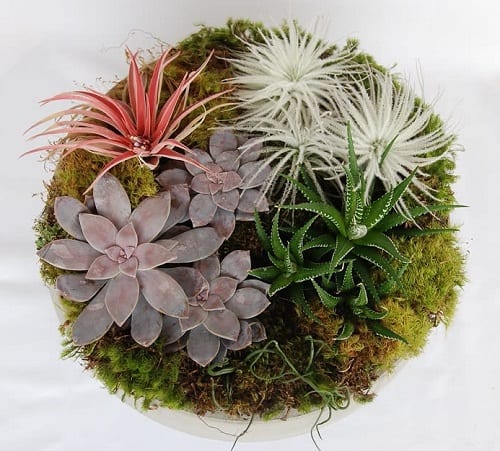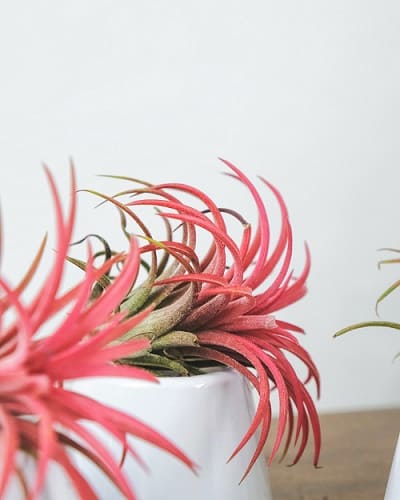Air Plants and Succulents: A Perfect Match
You know what’s really, really important? Hobbies. Especially in 2020 when we’re all stuck at home and not really allowed to go anywhere or do anything, having something to occupy your time is essential.
And it’s easy to say that if you don’t have one already you should go out and find yourself a hobby, but the truth is that it’s a little bit more complicated than that. Reason being you want to have the right hobby.
You want one that is going to benefit you in a number of different ways. Serving firstly to prevent yourself from feeling like you have no way of filling up your free time, while also having some mental and physical health advantages.
In a time when we’re discouraged from leaving out homes, a good hobby to pick up is one that encourages things like fresh air and sunlight, as well as one that helps you to keep in touch with nature even if you’re staying put.
That’s what makes gardening or keeping houseplants is the perfect hobby for lockdown. It keeps you active, it adds a dash of nature into your daily routine and watching your progress literally grow right in front of you is extremely fulfilling.
But gardening can be a huge commitment. For your plants to survive, they basically need constant monitoring and maintenance and maybe you’re looking for a hobby that’s fulfilling but which won’t be so demanding that it’s stressful.
And if that’s the case, you can still take up gardening and reap all the benefits of it, but you just have to approach it a little differently. This is where air plants and succulents come in, the perfect choice for the ‘neglectful gardener’.

So, for those who have never heard those terms before, what on Earth are air plants and succulents? Let’s have a look at each of them:
Air Plants

“Air plants” is actually just an alternate name for one specific type of plant known as the Tillandsia. Found most commonly in the deserts and mountains of Northern Mexico and the Southern States of the U.S, they’re fascinating little fellows.
The reason why they nickname ties into their reputation for being pretty simple to take care of. They’re called air plants because that’s where they get most of their nutrients from, the air around them.
And what this means for you as the gardener, is that there are certain things you would need to be keeping your eye on with several other plants that really aren’t much of an issue when it comes to air plants.
Firstly, they don’t grow in soil, this is what makes them such a good houseplant because you can literally just store them in any kind of container and they will be fine. They don’t need the nutrients from soil like so many other plants do.
They have roots but the purpose of them is to attach themselves to the surface they’re growing on. This makes sense when you consider that in their natural habitat they are most commonly found on rocks and shrubs.
So with soil out of the equation, that really does limit just how much effort you have to put into these plants. They do need water and sunlight but even those requirements aren’t anything hugely strenuous.
You can get away with watering them once a week. The best method is to actually soak them in water for about 15 or 20 minutes. When you consider the fact that you’re literally doing this once a week it doesn’t seem like much but it’s enough for the required nutrients to soak in.
And then if you’re keeping the plants inside, indirect sunlight is perfectly sufficient. You’ll be able to tell if your air plants are in need of a soak or if they need to be moved because the tips of the leaves will curl.
This probably won’t happen if you are actually keeping on top of soaking them once a week but just throw a glance at them occasionally to make sure there’s no evidence of curling and you should be good.
Succulents

Most people who deal with plants will prefer to have a few different on the go at the one time and so for those of you with air plants who are looking for more, succulents are the perfect match.
They are quite similar to air plants in some ways because they require little maintenance, reason being in this case that they have these thick and fleshy leaves in which they can store moisture.
Like air plants, they do need to be watered every once in a while but they are a desert plant which means that they can survive extended periods of time in very dry conditions so you can probably limit it to once a week too.
Also, because of their proclivity towards said dry climates and warmer temperatures, they do require quite a bit of illumination so full sunlight is what you should aim for here. If you’re planting them outside this should be easy enough to achieve.
But if you’re using them as a houseplant then be sure to pick an area where they will get a healthy dose of strong light from a full sun, or opt to use plant grow lights. As for storage, you can keep these in pots of well-drained soil, and no fertilizer is necessary.
Succulents come in a pretty wide variety of different sizes, colours and shapes so you can have your pick of what you think will look best in your home or garden, they can give a great desert-like sense to the environment.
In addition to the fact that these plants are super easy to manage, they’re also very aesthetically pleasing, they’re unique looking plants which you don’t often see in peoples homes and so they’ll be sure to catch the eyes of any visitors.
As I said, having plants around is a great mood booster and having something to take care of, even if it’s low-maintenance can give you a really strong sense of fulfillment and purpose. So air plants and succulents are well worth the little time they’ll cost you to take care of them.
